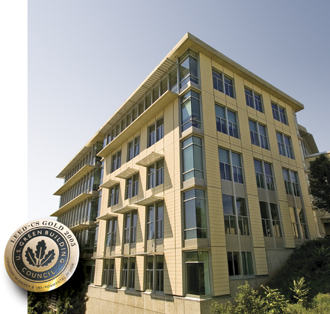
Carnegie Mellon’s Collaborative Innovation Center is a new model for industry-university partnerships
Like every other research university in the United States, Carnegie Mellon has hosted company-sponsored research almost from the day it opened its doors a century ago.
But today’s high-tech companies—many of which sprang from a university environment—need a fresh approach.
“Innovation-intensive companies today need to be where research happens,” says Jared L. Cohon, president of Carnegie Mellon. “Research is part of their identity and essential to their survival.
“The Collaborative Innovation Center (CIC) brings companies right into the university community. This is a new, proactive model for university collaboration with industry, with clear benefits for the companies involved, for Carnegie Mellon, and for economic growth in the region.”
The CIC’s well-known tenants—Apple, Google, Intel, and a Microsoft sponsored lab—are bringing some high-tech panache to Forbes Avenue. The CIC’s light-filled, high-ceilinged offices are designed around large collaborative spaces, well suited to the work going on inside.
Started in 2005, the project is a partnership among the university, the Carnegie Museums, and local economic development organizations. It received funding from the Commonwealth of Pennsylvania. The building also houses offices of CyLab, the university’s computer security project.
“Intel was a pioneer of the idea of open collaboration with universities like Carnegie Mellon and has had a research lab in Pittsburgh since 2002,” says Todd Mowry, director of the Intel lab. “Our offices were first on Craig Street, just a 10-minute walk away.”
“But the CIC is right on campus, and that proximity has made a difference,” Mowry says. “We are much more a part of the community here, which is where we want to be. This day-to-day connection allows Intel staff to work more closely with CMU, and we all share a richer understanding of the science, of what is coming next.”
Kamal Nigam of Google agrees. “Being so close to Newell-Simon Hall means we have many informal opportunities to exchange ideas—Google has a seminar series that Carnegie Mellon people attend, or we run into people over lunch next door. It is easy to find talented students to be interns. The feeling that we are all collaborating together is a strong one.
For Apple, says engineering manager Yaniv Gur, the CIC was the obvious location to consolidate its offices in Pittsburgh.
“It seemed natural for Apple to be located at the technological heartbeat of the city, which is here,” Gur says. Apple does not conduct research at the office, but it does hire students to work on engineering operations. Apple’s office is also a base for Apple recruiters while they are in the city.
Although doctoral students win most of the internships at CIC, a few undergraduates are working on projects.
“This is an important benefit for the university, says Intel’s Mowry, who is on leave from the computer science faculty while directing the Intel lab.
“The CS faculty has long been concerned that very bright, intense students can take on too much, doing double majors with huge courseloads,” Mowry says. “But offering them a serious research opportunity channels this intensity into a more productive outlet.”
Companies can draw on expertise from across campus to configure their own panels of experts, which Carnegie Mellon people are accustomed to doing, McNulty says. Last summer, for example, Intel hired a design student and a Tepper student, who created an impressive business plan for a new medical diagnostics product.
Nigam believes that the CIC model will work for firms in such areas as biotechnology, entertainment technology, and robotics.
“I have been in Pittsburgh for 10 years, first as a Carnegie Mellon PhD student and now with Google, and it is exciting to see the technological community growing, with more people moving here to be a part of it,” Nigam says. “This community could grow in many directions, and the CIC is a great setting for this to happen.”
RELATED LINKS:
Collaborative Innovation Center
Tenants
Sustainable Design
Todd Mowry
Kamal Nigam
Carnegie Mellon School of Computer Science



